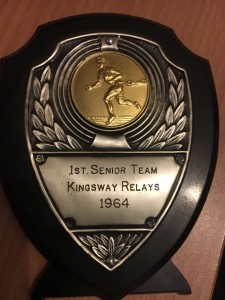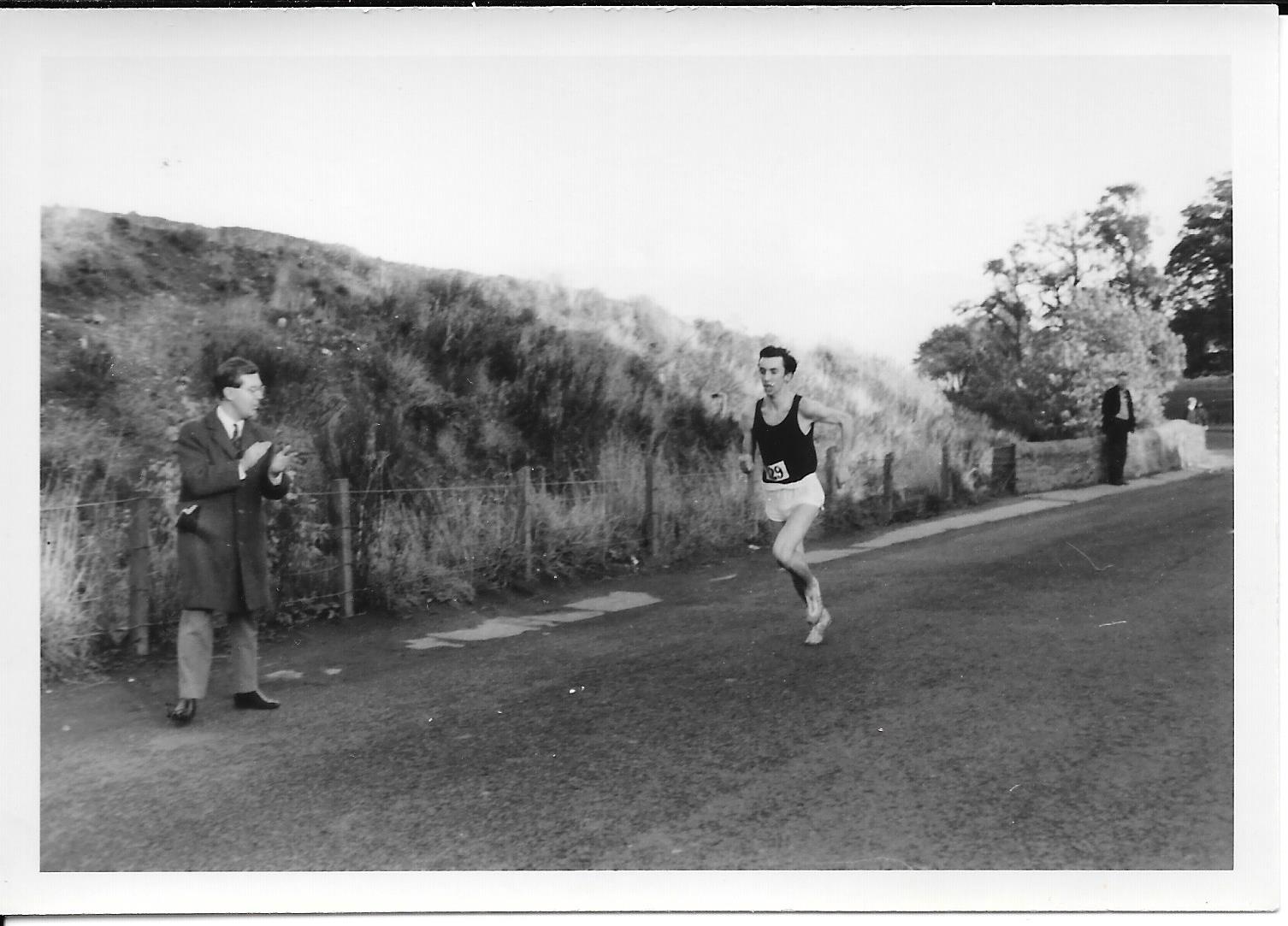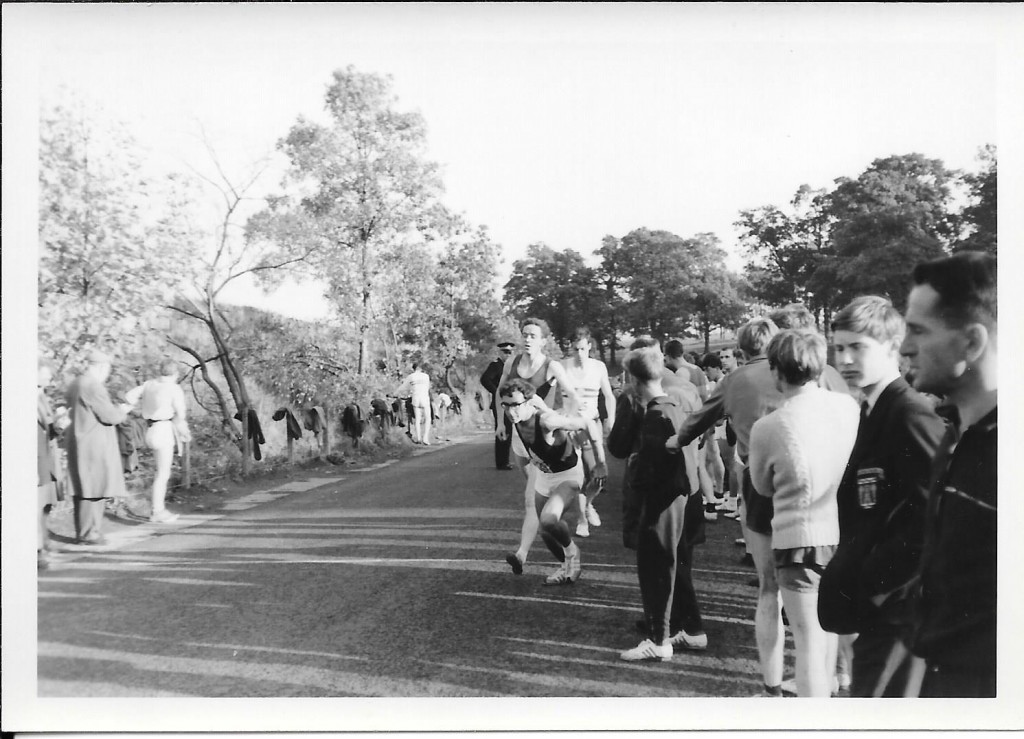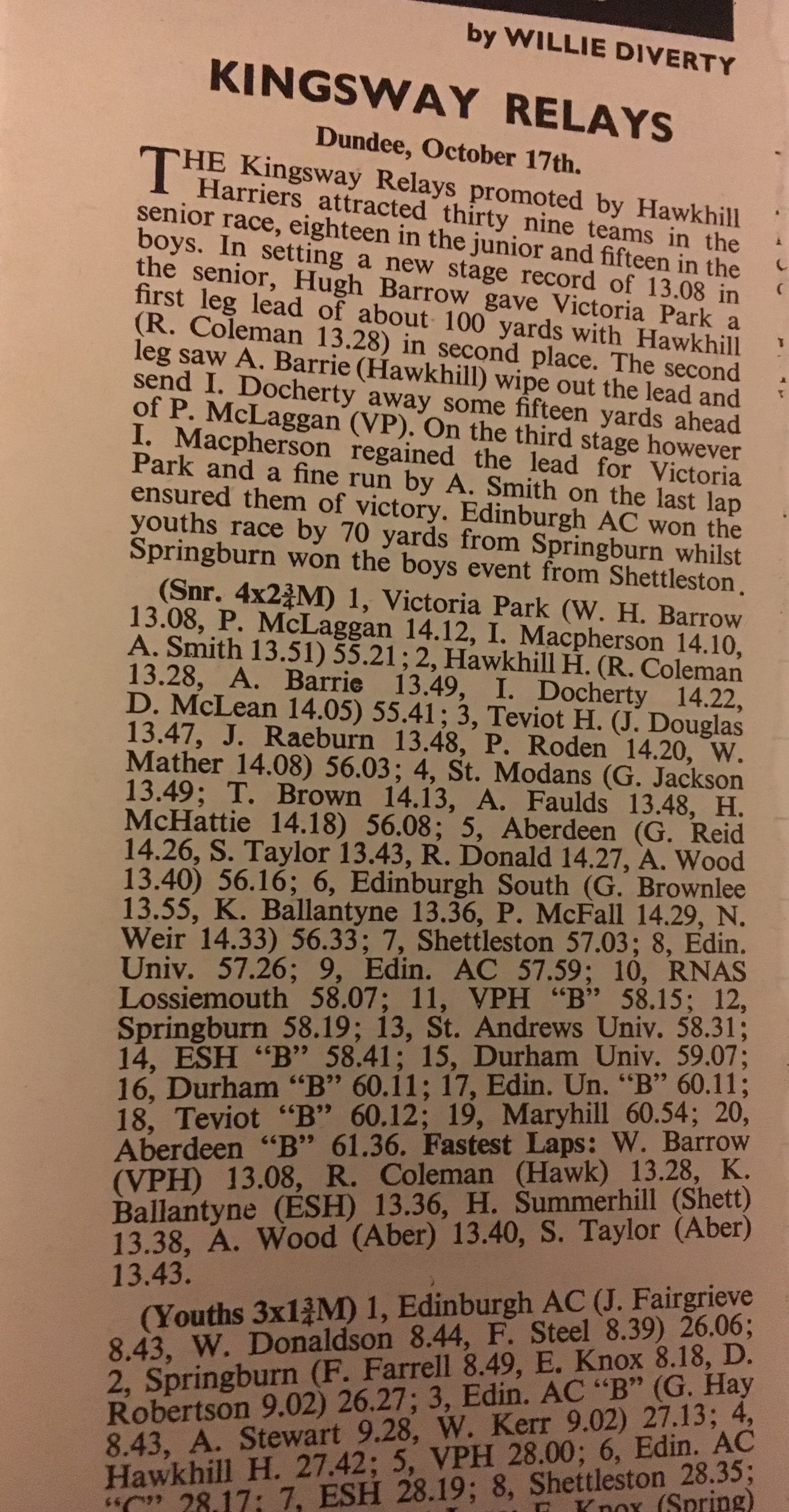The start of the winter season was always the relays – four man relays on the road and then over the country as a lead-in to the season. All endurance runners ran in them. They gave the track specialists over a mile or two miles a chance to up the distance gradually, and also helped the marathon and longer road runners get the pace for the winter season. Usually over anything from two and a quarter miles to three and a half miles, on surfaces varying from week to week (two miles cross-country in Ayrshire was vastly different to two miles round a Glasgow park) and stage to stage (the trails on the country were heavier for the last leg runners than for the first), nothing could be read into the times other than as they compared with each other on the day. After the war in 1945, the start was usually the McAndrew Road Relay at Scotstoun, followed by the Dundee Kingsway Road Relay and then the county relays in the west and the District Relays the week after that. They were great club events with great team spirit, hard fought out races and the friendliest of club rivalries. Least known to the present generation of runners is the Dundee race. The story of its conception and development is told in the November, 1946 issue of Walter Ross’s marvellous ‘Scots Athlete’ magazine and we can start by reproducing it here. The picture is of Eddie Knox in the 1966 Kingsway Relay.
STORY OF THE “KINGSWAY” RELAY
by D.M. THOMSON
Firmly established in the West of Scotland as the official “curtain raiser” to the cross-country season, Victoria Park’s popular “McAndrew Relay” is an event with which cross-country enthusiasts have long been familiar. The “Kingsway” can make no claim to such mellow vintage and to members of clubs now resuming operations after years of enforced inactivity, and, to others whose only knowledge of it is what appears in the Press, the mention of the Kingsway Relay must bring to the mind quite a crop of whys and wherefores. True, it did not exist pre-1939, yet, since its inception in 1941 it has enjoyed the ever increasing support of the leading Glasgow clubs whose entries this year were augmented by those of the revived Edinburgh Northern and Southern clubs, and Kirkcaldy YMCA, though unfortunately the Northern were unable to travel.
Undoubtedly inadequate competiton during the war years had much to do with the success this event has achieved and so far as I am concerned, I am content to leave it at that. As one who had what might be termed a fatherly interest in the birth of this war-time babe, your Editor, in what must be one of his rare moments of indiscrimination, has asked me to relate how the Kingsway Relay originated, and to give a resume of its subsequent history. To do so, I shall have to draw on the strings of memory for some time, and, I trust, any resultant discords in the form of inaccuracies will be pardoned on the grounds that, at the time and place of writing, I have but the scantiest of records on which to work.
At the outset let me inform you that, when the race was first mooted by Jim Brannen, Alec Mudie, Peter Henderson and myself, any thought that it would become one of the leading road races in the country never occurred to us. Such a possibility was never even considered. All that we were concerned with then was arranging what, we hoped, would be an attractive opening fixture for the 1941-42 cross-country season.
In Seasons 1939-40 and 1940-41, you will doubtless recollect, there were pretty drab and uninspiring events everywhere, but nowhere, do I think, as dismal as in Dundee. Of the score or so clubs affiliated in the Eastern District Committee, NCCU, in 1937-38, all but Thistle and Hawkhill were, through force of circumstances, obliged to close down for the duration. Rapidly depleting memberships, owing to the call-up, scarcity of recruits, and lack of competition, resulted in a not-unnatural waning of interest in the ranks.
HAWKS AND THISTLE UNITED
During this period of athletic depression, Hitler & Co decided to “eliminate” Thistle’s headquarters. The obvious solution was followed. Hawks and Thistle amalgamated for the duration, and proceded to operate from the former club’s premises under the name “Dundee Harriers”.
About the same time there came into being the Dundee Central Council for the Entertainment and Welfare of the Forces. Jim Brannen, who was in the process of making a “come-back” after 10 years of retirement, became athletics convener, in which capacity he, more or less, had a free hand and was successful in obtaining the ready and willing co-operation of the Sports Officers of the various officers in the District. Towards the end of seasion 1940-41 things were moving nicely, so much so, that plans were made for the formation of an Eastern Cross-Country League for season 1941-42.The League was to comprise units from Service units in the District, St Andrews University, where cross-country running had found a number of enthusiastic adherents, and Dundee Harriers.
The programme was to consist of a series of team races, but, as a sort of get-together, it was decided to hold a six-per-team relay race, in Dundee, early in October 1941. In close proximity to Hawkhill’s clubrooms stretches the Kingsway by-pass road which skirts Dundee from west to east. Used regularly as training territory by Hawkhill since they first established themselves at Fairfield Street, the Kingsway was accepted by club members as nothing more than that. But to Alec Mudie, the Club Secretary, this highway, with its trim carriageways, had long suggested great possibilities as a relay course. Its beauty lay in its simplicity. It was straight, flat and required the minimum of stewarding. His suggestion that the league relay race be held on the Kingsay course was accepted unanimously and, accordingly, the constituent clubs were duly notified. The course mapped out was over a mile stretch of the highway, the runners starting at the midway mark, running for half a mile along the west-bound cariageway, before turning to the eastbound, of which they had to cover a mile before turning back on to the west-bound carriage for the half-mile to complete the circuit. That was all there was to it. Nothing to it at all, or so we thought in September 1941.
However the preliminary canters with the Service Units at the end of the past season had whetted the competitive appetite of our fellows, and, as the new season approached, they were impatient to get into action once more. So new ground was trodden, and a team entered for the 1941 “McAndrew”.
Jim Brannen, Culprit-in-chief
As it transpired, it was at Scotstoun that our quiet little league relay took the K.O., and in its stead there emerged the colossal, gigantic, stupendous Dundee “Kingsway Relay”, open to all the world. I was not present when this bombshell burst, but, knowing Jim Brannen, culprit-in-chief, as I do, I have no doubt that the attractions of the “Kingsway” relay would be painted in glorious technicolour. At any rate, the first my colleague and I heard about it was on the Monday following the McAndrew. To say that we were surprised would beexpressing our feelings mildly. Garscube and Maryhill were definitely coming, and possibly others. Jim Brannen informed us. Garscube we did not mind so much, for, after all, we regarded them as the Glasgow branch of the Thistle Harriers at the time. But Maryhill! We were filled with awe. Just as we were recovering, we were informed that we would have to find a cup. “What cup?” we asked. It appeared the cup in question was to be awarded to the winning team, and would be known as “The Kingsway Cup”. We also learned first and second teams were to get prizes, and that there was also to be a prize for the fastest lap.
Finding the Cup
The race was formally constituted there and then, and ways and means of acquiring the necessary awards discussed at length for we had only a week in which to do the needful. However, the Cup problem was soon solved. The Hawks had a cup which had become redundant on the demise of their one-time ladies section, and it was decided to rename this trophy “The Kingsway Cup”. Some hurried lobbying of a few friends of the sport culminated in substantial and tangible gifts being made to the prize fund. The stage was now set for the first Kingsway Relay. Our initial misgivings had long since evaporated, and we looked forward with keen anticipation to welcoming our Glasgow guests on their first visit to Tayside.
Came the great day. If I remember aright, we had an entry of about a dozen teams, most of which were from the Services. It was a great race. Garscube, right on the crest that season finished worthy winners, with Maryhill a good second. The winners’ time for the six two mile laps was 66 min 29 sec. Emmet Farrell had the distinction of returning the fastest lap, his time being 10 min 26 sec. The Glasgow runners were complimentary almost to the point of embarrassment. The course, in particular, impressed, and, somehow or other, it became a generally accepted fact that the event would be an annual one. That then is how the Kingsway Relay came into being.
Alec Donnet’s Spade Work
So far as the subsequent races are concerned, tribute must be paid to the efforts of Alec Donnet, our new NCCU Vice-President, whose spade-workdid much to maintain and spur further interest in our event. For the 1943 race, the team composition was reduced to the more orthodox four runners, and the lap was increased to approximately three miles. By this time the Hawks headquarters had been requisitioned by the NFS, but the fact that we had no home to call our own did not deter us. Thanks to old friend Jack Quskley, the pavilion at the nearby UCD grounds was put at our disposal for the day. The entry had increased to about 20 teams for this year and, I think, it was on this occasion that Shettleston made their debut. It was Maryhill’s turn this time, their winning quartet aggregating 58 min 28 sec. We locals were more than satisfied with Jim Brannen winning the fastest lap award with a fine 14:14.
In the 1944 race, Maryhill again came out on top, and Farrell again gained the individual award making it a Maryhill double. It has to be admitted that we blotted our copybook that day. Bad stewarding turned the first lap leaders on to the home stretch considerably before the appointed spot, while the rest of the field, following the lead and advice of oneof the local runners went on to complete the circuit. To rectify the position second lap men were to run a long or a short lap, as the case happened to be. At the end of this lap things had been pretty well ironed out, but, as a spectacle, the race had been spoiled.”
In 1944 it was another double first for Maryhill and Emmet Farrell with new records by both; 1945 saw another double first, but this time for Shettleston and Harry Howard. 1946 however was when, with the war well and truly over, the race really took off. 27 teams competed and the first twelve teams were
- Maryhill Harriers A 58:18 2. Bellahouston Harriers 58:50 3. Victoria Park A 59:07 4. Shettleston Harriers A 59:39 5. Thistle Harriers 60:44 6. Maryhill Harriers B 61:40 7. Garscube Harriers 61:42 8. Shettleston Harriers B 61:48 9. HMS Condor A 61:50 10. Hawkhill Harriers A 61:58 11. Edinburgh Southern Harriers 62:33 12. Kirkcaldy YMCA 62:55.
- As an indication of the quality of the individual runners, fastest man was Andy Forbes of Victoria Park, whose 14:22 was only 1 second faster than Emmet Farrell’s in second. Third saw J Clark of Maryhill and C McLennan of Shettleston equal on 14:28 with Alex McLean of Bellahouston (14:31) and Charlie Robertson (14:32) fifth and sixth.
The race had been well and truly accepted by the athletics community.
Kenny Lunn and Duncan Middleton of Springburn in 1966
Colin Youngson took part in this event eight times between 1966 and 1977, and has been kind enough to contribute his memories of the race.
From 1966 to 1971, when I ran for Aberdeen University Hare & Hounds Club, I raced many times on the road in Dundee, Glasgow, Edinburgh, Aberdeen and near Inverness. There was less traffic in those days, the police granted permission easily and fewer runners took part, since this was well before the jogging boom. Now many of these fine traditional races are long gone, including the fantastic Edinburgh to Glasgow Relay and the very first significant event I took part in – The Kingsway Relays in Dundee.
On Saturday the 15th of October 1966, only a month after becoming a student, I found myself running for the AU second team in a major competition. The Kingsways were extremely popular and many of the top Scottish athletic clubs – from Edinburgh and Glasgow as well as Aberdeen, Dundee and Perth – participated. The Winter Season commenced on 1st October, followed by a flurry of fixtures preparing for the E to G in late November. From the direction of Perth, the Kingsway itself is a major thoroughfare which passes the top of Caird Park and then leads into the heart of Dundee. Each team had four runners who raced round the same 2.9 mile loop. The start was below the park, on a local road parallel to the Kingsway. A massed start (in those days, about 40 runners) charged off for about a mile, before cutting left uphill, and then left again at the main road. So far, tarmac had been the surface, but now (due to heavy traffic) the route followed a path between road and park perimeter hedge. This featured some tarmac, but also bare soil which, in lightweight ‘Tiger Cub’ racing shoes, could be treacherous when wet. Eventually the Aberdeen roundabout was reached, where one turned sharp left onto the pavement and zoomed, almost tumbled, down the steep slope, before another sharp left and a straight sprint to the handover point.
Dundee Hawkhill Harriers organised the senior relay and some shorter ones for boys and youths too. This was the first senior fixture I had attended. I must have been running one of the later legs, because my main memory is of jogging round the course in reverse to warm up. We reached the top of the hill and gazed down the path to watch the first stage runners approaching. To my awe, a lone runner appeared and rapidly came nearer, an incredible distance in front of his pursuers. This champion, running with power and total control, turned out to be John Linaker of Pitreavie, a great Scottish athlete with (I discovered more than thirty years later) a marvellous personality. He must have run 13 minutes 20-odd seconds; whereas I did 15.26 and could only dream of being anything like as fast as him. Still, road relay running suited me – the determination not to let the team down, the excitement of sprinting away, hanging on like mad and struggling to the finish, using every available drop of energy. Tactics were minimal – this was an opportunity for challenge and total commitment. AU finished twentieth.
In subsequent years, my times improved gradually: 1967 14.30 with AU 8th; 1968 14.19, one second in front of my main club rival Don Ritchie, with AU 10th (Lachie Stewart from Shettleston ran 13.15!); 1969 14.09, with AU 8th (Fergus Murray from Edinburgh ran 13.25 to pip Dick Wedlock from Shettleston); 1970 13.57, again one second faster than Don, with AU up to 3rd, not bad for a student team.
By 1972 I was representing Victoria Park A.C. I have a full set of results for the Kingsway that year. Edinburgh Southern (Allister Hutton, Martin Craven, Gareth Bryan Jones and Fergus Murray) won in 55.17; with VPAAC (Davie McMeekin, Colin Youngson, Hugh Barrow and Albie Smith) second in 56.15. However we led until halfway! Third in 56.34 were Clydesdale Harriers (Alan Marshall, Phil Dolan, Allan Faulds and Dougie Gemmell). Amazingly, my 13.32 was fastest of the day, one second in front of Gareth, and I was presented with the Brannen Memorial Cup. The engraved names of past winners seemed embarrassingly illustrious. The prize was a Boots token for, I believe, half a crown, and I still possess the Pears Cyclopaedia and Dictionary I bought with it. Professional Athletics, eh?
My next participation in the Kingsway Relays was in 1975. After a year teaching in Sweden, on my return to Scotland I had joined the best club in Scotland, ESH, and we had no difficulty in winning the race in 55.25. Our ‘B’ team had the temerity to stick its nose in front at halfway, courtesy of Martin Craven and Nigel Bailey, who edged the ‘A’ team’s Craig Douglas (13.47) and Don Macgregor. However Alistair Blamire restored propriety with the day’s fastest time (13.39) and I made sure the winning distance was respectable with 13.48. Eventually Edinburgh Athletic Club (Dave Taylor, Danny Knowles, Doug Gunstone and Jim Wight) were second in 57.17, with our ‘B’ team third. Then in 1977 ESH finished second to EAC, and I was second-fastest, two seconds behind Willie Sheridan (of VPAAC or Glasgow University). I have no idea when, or why, this fine race ceased but surely, given the low-traffic nature of the course, there is no good reason why it could not be revived.
*
That’s where Colin’s reminiscences end and they indicate the quality of runner attracted to Tayside for the event. Further evidence is in this copy of the results, sent by Hugh Barrow who still holds the record for the race, from 1964. Just look at the Aberdeen team for a start and they were down in fifth. Note also, from the top of the page the fact that me men were running for the sake of the race rather than the money!



